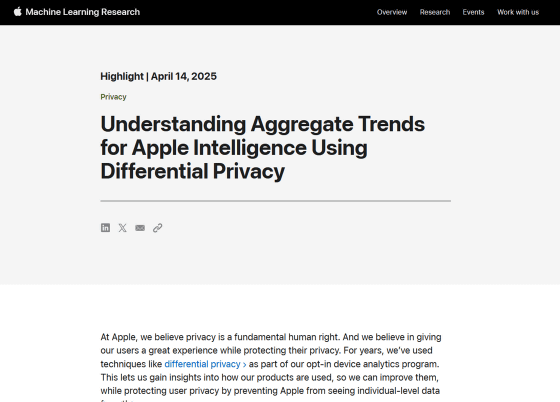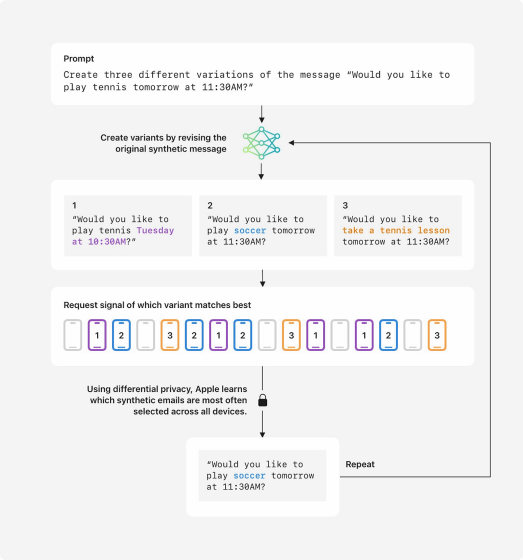Apple explains how Apple Intelligence uses user data to improve AI while protecting privacy

Apple has developed the AI platform 'Apple Intelligence,' and the Japanese version is now available on iPhones, iPads, etc. with 'iOS 18.4,' 'iPadOS 18.4,' and 'macOS Sequoia 15.4,' released on Monday, March 31, 2025. In order to improve the performance of such Apple Intelligence, Apple explains 'how to use user data to improve AI while protecting privacy.'
Understanding Aggregate Trends for Apple Intelligence Using Differential Privacy - Apple Machine Learning Research

Apple to Analyze User Data on Devices to Bolster AI Technology - Bloomberg
https://www.bloomberg.com/news/articles/2025-04-14/apple-to-analyze-user-data-on-devices-to-bolster-ai-technology
Apple's complicated plan to improve its AI while protecting privacy | The Verge
https://www.theverge.com/news/648496/apple-improve-ai-models-differential-privacy
In a blog post, Apple said, 'At Apple, we believe privacy is a fundamental human right. We believe we can protect your privacy while still giving you a great experience.'
The policy of protecting user privacy is also maintained in Apple Intelligence, the AI platform. Apple says that it does not use any personal data or interactions of users when training the underlying models of Apple Intelligence, and that it removes personal information from content publicly available on the internet before using it.
But 'synthetic data,' which mimics real-world inputs without including personal information, isn't necessarily representative of customer data. As a result, Bloomberg points out that AI trained on synthetic data may not work properly.

Therefore, Apple is using a technique called 'differential privacy' to use user data while protecting privacy. Differential privacy is a method to identify popular prompts and patterns without collecting data linked to individual users, and is already used in 'Genmoji', which creates custom emojis with Apple Intelligence.
Differential privacy detects prompts and word signals anonymously when multiple users request emojis including 'dinosaurs wearing cowboy hats.' A particular word must be used by many users to be detected, and the signals Apple receives do not contain IP addresses or IDs that can be linked to Apple accounts, so user data can be used while protecting user privacy.
Apple is already using differential privacy to improve Genmoji, and in future releases it will apply the approach to its image generation tool,
I tried using Apple Intelligence's 'ability to ask AI for details of what is captured by the camera' and 'eraser magic-like function that can erase unnecessary objects in an image' - GIGAZINE

On the other hand, Apple Intelligence's writing features, such as summarization tools and long text manipulation, are not as effective with short prompts like Genmoji, so Apple has developed a way to improve text generation using synthetic and user data.
This method first generates synthetic data that mimics real emails and messages, then extracts embeddings that contain elements of the synthetic messages, such as words, topics, and length. These embeddings are then sent to a small number of user devices and compared with emails and messages created by real users to improve the accuracy of the data.
The diagram below shows how embedded representations of various synthetic data are sent to the device and the feedback obtained is used to improve the AI. Differential privacy can be used here as well to improve the performance of Apple Intelligence while protecting user privacy.

Apple will use the synthetic data to improve email text generation in future beta software. Note that the use of user data to improve Apple Intelligence will only be available to users who have agreed to send analytics information under ' Device Analytics and Privacy .'
'These technologies allow Apple to understand trends without knowing any personal information about you, such as prompts you used or the content of your emails,' Apple said. 'Apple continues to advance cutting-edge machine learning and AI techniques to improve product experiences, while also remaining committed to developing and implementing cutting-edge technologies to protect user privacy.'
Related Posts:
in Software, Web Service, Smartphone, Posted by log1h_ik







